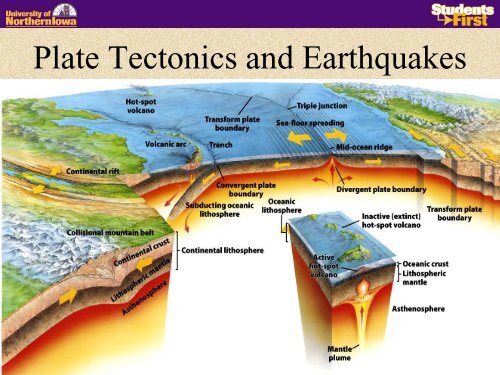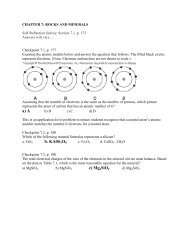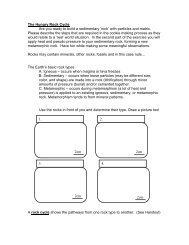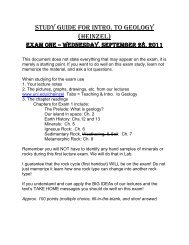Plate Tectonics and Earthquakes
Plate Tectonics and Earthquakes
Plate Tectonics and Earthquakes
You also want an ePaper? Increase the reach of your titles
YUMPU automatically turns print PDFs into web optimized ePapers that Google loves.
<strong>Plate</strong> <strong>Tectonics</strong> <strong>and</strong> <strong>Earthquakes</strong>
Big Idea• The Earth’s interior is in constant motionthrough the processes of convection, withimportant consequences for the surface.
History• Alfred Wegener• 1910 to 1925• Continental drifthypothesis
Pangaea
1650
1676
1893
TodayThe Mid-AtlanticSpreading Ridge
LaurasiaGondwanal<strong>and</strong>
Supporting Evidence
Fossils
Glossopteris
<strong>Plate</strong><strong>Tectonics</strong>• <strong>Plate</strong>– Passive shells– Lithosphere• Crust• Upper Mantle– 100-200 km thick• <strong>Tectonics</strong>– Folds– Fractures– Faults
<strong>Plate</strong>s
Big Idea• The Earth’s tectonic plates consist of rockycrust (lithosphere), the upper most mantle,<strong>and</strong> move slowly with respect to oneanother.
MohoIsostasy
Tectonic <strong>Plate</strong>s
Big Idea• Many active geologic processes occur atplate boundaries.
Exploring Earth’s Interior
• P-waves (Primary)Seismic Waves– Compression (push-pull)• S-waves (Secondary)– Shear (side-to-side)• Wave behavior Vs. the Chemical <strong>and</strong>Physical nature of a Material
<strong>Plate</strong> tectonics <strong>and</strong> earthquakes
<strong>Plate</strong> tectonics <strong>and</strong> volcanoes
North America
NorthAmerica
North America
North America
NorthAmerica
Today
<strong>Plate</strong> movement• Divergent boundaries (Spreading centers)– Tension, pull-apart• Convergent boundaries (Subduction)– Compression, shorten-compress• Transform boundaries– Shear, side-by-side movement
<strong>Tectonics</strong> <strong>and</strong> Sea-FloorSpreading
Mid-AtlanticOceanic Trench
Global Ridge Networks
Sea-floor heat index
Magnetic properties of Earth
• 171 reversals in 76 Ma• Rate of <strong>Plate</strong> movement– Distance (Anomaly toridge)/Anomaly Age• <strong>Plate</strong> movement (2 to18 cm per year)
East African Rift
Mid-continent Rift(1.1 Ga)Ray Anderson (link)
The Hawaiian Hot Spot• Hot spots– Rising magma– Flows through the convective motion of themantle.
<strong>Earthquakes</strong>
Cause of <strong>Earthquakes</strong>• Moving <strong>Plate</strong>s• Build up• ReleaseConvection
<strong>Earthquakes</strong>, Energy, & Waves• P-waves, (Primary)• S-waves, (Secondary)• Surface waves– A combination many waves (Love,horizontal movement <strong>and</strong> Rayleigh, rollingmotion)
Measuring the Energy of an Earthquake• Richter Magnitude Scale• Modified Mercalli Scale (Intensity)
The Richter Scale• Direct measurement of the P <strong>and</strong> S-wave intensities.Seismograph
Modified Mercalli Scale• Based on verbal or written accounts of whatpeople felt.• Advantage, historical records
Fault• A fracture or system offractures along which rockshave been displaced.
Fault types• Normal• Reverse• Strike slip– Right lateral– Left lateral
Trip to the Web• USGS– The United States Geological Survey
Intra-plate earthquakes
Intra-plate <strong>Earthquakes</strong>• Deeply buried• Typically do not break the ground surface.• Strong rock with few breaks– Transmit seismic waves rapidly• Increased ground motion– Increased surface damage
The New Madrid Seismic Zone
• 8.2 MMThe 1812 New MadridEarthquake• Caused church bells to ring in WashingtonD.C. (630miles away)!• Changed the course of the Mississippi River
Secondary earthquake products








